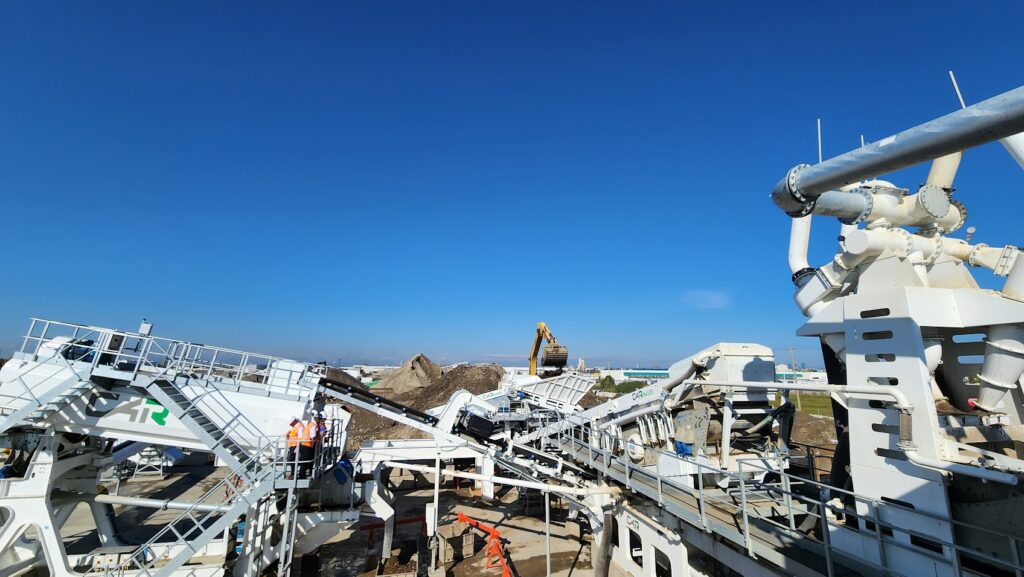Last week, the Mineralocity Aggregates team had the distinct pleasure of touring Calgary Aggregate Recycling Inc., in Calgary, Alberta. The occasion was a special open house hosted by CDE, an Irish company at the forefront of traditional aggregate processing and cutting-edge recycling technology. This experience provided invaluable insights into the sustainable future of aggregate processing and recycling.
CDE: Pioneering a Circular Economy in Aggregate Recycling
Before diving into the tour details, it’s important to understand the role that CDE plays in the aggregate recycling industry. With the motto, “Engineered for a Circular Economy,” CDE is doing more than just pioneering waste recycling; they’re laying the groundwork for a more sustainable future. They specialize in providing wet processing solutions that divert over 20 million tons of waste from landfills annually. Whether it’s construction and demolition waste, contaminated soils, or hydro excavation waste, CDE transforms these materials into valuable construction resources.
What We Saw: The Aggregate Recycling Process
During our tour, we were fortunate enough to see the plant process different types of waste, including excavation and hydro excavation waste. The system, efficient and precise, separates the waste into sorted, washed, and screened streams of rock, sand, and fines.
Sustainability in Action: Closed-Loop Water System

A highlight of the plant’s operation was its closed-loop water system, which recycles ~95% of the water used. This feature not only conserves a critical natural resource but also allows the plant to function with a minimal environmental footprint. This allows for faster permitting and a lower impact footprint.
Efficiency: Monitoring from a Single Dashboard
What stood out during the tour was the plant’s commitment to efficiency. Every aspect of the operation can be monitored from a single dashboard, ensuring that each element runs at peak efficiency to maximize uptime. This is a crucial aspect for any plant that aims to be both profitable and sustainable.
Implications for the Future
Rethinking Waste Management
The tour was more than just an educational experience; it was an inspiring vision of the potential that lies ahead. One of the most immediate takeaways was the need to reevaluate our perceptions of waste. Traditionally viewed as something to discard, waste, as demonstrated by Calgary Aggregate Recycling Inc. and CDE, can be a valuable resource.
Scalability and Adaptability
The advanced technologies we observed have significant scalability and adaptability potential. With CDE’s wet processing solutions capable of diverting over 20 million tons of waste from landfills annually, one can only imagine the global impact if more such facilities were to adopt these technologies. And given that these technologies can be adapted to handle various types of waste—from excavation waste to contaminated soils—it opens doors for widespread industry adoption. We were told that CDE can build these plants to handle as little as 70tph to as much as 700tph. They also offer custom solutions that could potentially be even larger.
Economic Benefits
While the environmental implications are obvious, there are also substantial economic benefits to consider. The plant’s closed-loop water system, for example, significantly reduces water costs. The ability to monitor every aspect of the operation from a single dashboard allows for real-time decision-making, reducing downtime and boosting profitability.
Policy and Regulatory Implications
The success of facilities like Calgary Aggregate Recycling Inc. should encourage policymakers to support sustainable practices in the aggregate industry. By doing so, they can facilitate the transition from traditional waste management to circular economic models that are both profitable and beneficial for the planet.
A Forward-Looking Approach
In a world that’s increasingly cognizant of environmental responsibility, adopting the practices showcased during our tour is more than just good business sense—it’s a societal imperative. Companies that are quick to embrace these technologies not only stand to gain a competitive edge but also become leaders in setting new industry standards.
By embedding these forward-thinking practices into our industry’s operations, we not only mitigate our environmental impact but also create a more resilient, cost-effective, and ultimately more sustainable business landscape. The tour reaffirmed our belief that with the right technologies and practices, the aggregate industry has a bright and sustainable future.
Conclusion

The tour of Calgary Aggregate Recycling Inc. was eye-opening, to say the least. It revealed a glimpse of what is possible when innovation meets sustainability. With companies like CDE leading the way, the future of aggregate recycling is not just promising; it’s imperative. And for teams like ours at Mineralocity Aggregates, it affirms our commitment to be part of this sustainable future.


